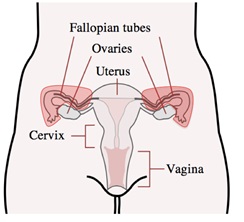RRESDO: A two-step operation involving removal of the fallopian tubes first followed by the ovaries at a later time
 Before surgery: Before surgery you will have an ultrasound scan to look at your ovaries and a blood test to measure your CA125 and hormone levels (FSH). You will also be asked to complete a questionnaire. This can be returned directly to the PROTECTOR study team using the freepost envelope you will be provided with.
Before surgery: Before surgery you will have an ultrasound scan to look at your ovaries and a blood test to measure your CA125 and hormone levels (FSH). You will also be asked to complete a questionnaire. This can be returned directly to the PROTECTOR study team using the freepost envelope you will be provided with.
Surgery: You will undergo two separate operations. The first operation involves removing both your fallopian tubes. Once you have reached menopause naturally or sooner if you wish, a second operation will be performed to remove your ovaries. At both operations we will also collect some fluid (washings) from the abdomen (tummy). This will be sent together with the tissue we removed at surgery for examination by specialists called pathologists. The pathologist will carefully examine this under a microscope to look for any abnormal cells or signs of cancer/ pre-cancer. The surgery for the majority of women will be keyhole. The average hospital stay associated with keyhole surgery is 1 day, compared with 5 days for open surgery.
Follow up after surgery: Four weeks after each operation, your doctor will be able to give you the results of the tissue examined by the pathologist. You will also have a follow up blood test three months after both surgeries and once a year for three years after your first surgery, to measure your hormone levels (FSH). You will also receive follow up questionnaires (together with freepost envelopes) in the post once a year for three years. A small number of women will also be invited to take part in an interview. Separate consent is sought for this. Interviews will explore views on acceptability, interest, factors influencing decision making and willingness to undergo the risk reducing surgery for preventing ovarian cancer.


